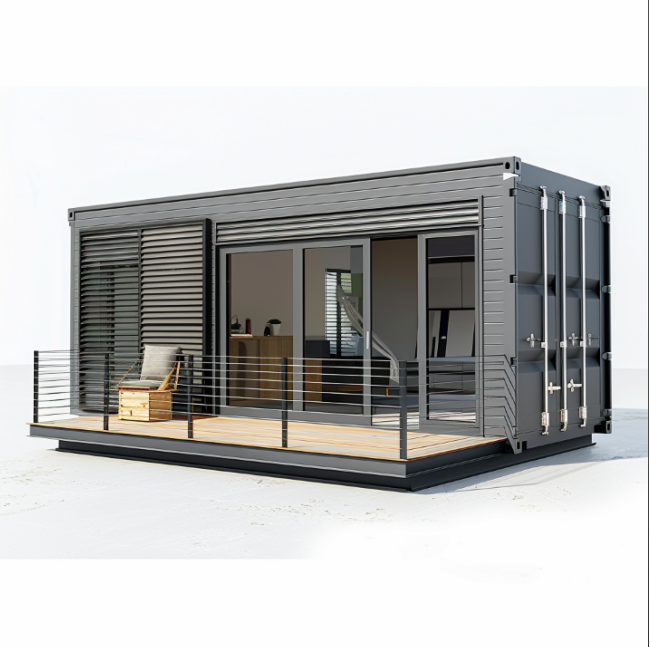Defining Prefabricated Construction
Prefabricated construction, also known as prefab housing, involves assembling building components at a manufacturing site before transporting them for final assembly. This approach not only enhances the speed of construction but also reduces waste and improves accuracy compared to traditional methods. The Modular Building Institute reports that prefabricated construction can reduce construction time by up to 50%, showcasing its efficiency in assembling modular homes and other prefabricated structures. This method aligns well with the increasing demand for mobile and tiny homes due to its adaptability and quick turnaround.
Core Requirements for Prefab Materials
In prefab housing, materials must meet specific criteria to ensure the overall safety, durability, and sustainability of the final structure. Firstly, these materials must be durable and lightweight, while still complying with all relevant building codes. This ensures that prefab homes remain safe and sustainable throughout their lifespan. Secondly, thermal performance and energy efficiency are critical components in reducing operational costs post-construction. Studies have exhibited significant energy savings in prefab builds, emphasizing the importance of choosing resources that bolster energy efficiency. Lastly, adherence to environmental regulations safeguards against negative environmental impacts, securing that prefab homes contribute to a greener future.
Key Components in Modular Home Assembly
The assembly of modular homes relies on several key components, including wall panels, floor systems, roofs, and structural frames, that collectively ensure the integrity and longevity of the structure. Utilizing advanced manufacturing techniques allows for precise fittings, enhancing the overall quality of prefab houses and constructed buildings. Research indicates that modular homes offer lower overall construction costs largely due to efficient component manufacturing processes tailored to prefab housing. This efficiency is increasingly appealing to those looking to build sustainable prefab houses, mobile homes, and even tiny homes with both economic and environmental benefits.
Steel Framing for Mobile Home Durability
Steel framing is a preferred choice in mobile home construction due to its strength and resistance to environmental factors, ensuring durability and longevity. It provides enhanced structural integrity, minimizing maintenance needs associated with traditional lumber. The American Iron and Steel Institute has demonstrated that steel-framed structures surpass wood in terms of strength, offering long-term resilience and the potential for recycling at the end of the life cycle.
Engineered Wood in Tiny Home Design
Engineered wood has emerged as a sustainable and versatile alternative in the construction of tiny homes. This material offers improved dimensional stability and strength compared to traditional wood, making it ideal for compact structures. Studies highlight that engineered wood production leads to a significant reduction in material waste, promoting environmental benefits in tiny home design.
Concrete Applications in Pre-Fabricated Homes
Concrete is renowned for its fire resistance and durability, making it suitable for prefab homes across various climates. Precast concrete components not only expedite construction timelines but also significantly reduce labor costs. Homes utilizing concrete often enjoy lower insurance premiums due to their enhanced safety features, as supported by statistical evidence indicating the material's effectiveness in lowering risk.
Composite Materials for Modular Efficiency
Composite materials are recognized for their combination of strength and lightweight properties, which facilitate ease of transportation and assembly crucial for modular homes. They provide superior insulation, significantly enhancing energy efficiency and reducing operational costs. Reports suggest that integrating composite materials in construction improves structural performance while effectively lowering the overall expenses associated with prefab housing.
Eco-Friendly Innovations in Modular Homes
Eco-friendly innovations play a significant role in enhancing the sustainability of modular homes. Incorporating solar panels and using sustainable materials are pivotal in reducing the environmental impact of these homes. By designing prefab houses with green materials, we can significantly lower carbon footprints and contribute to a healthier planet. According to the U.S. Green Building Council, implementing green building practices can lead to energy use reductions of between 20% and 30%. This demonstrates how integrating eco-friendly solutions in modular homes not only promotes sustainability but also results in significant cost savings over time.
Recycled Materials for Tiny Home Construction
The use of recycled materials in tiny home construction presents an excellent opportunity to lower costs and support environmental sustainability initiatives. By incorporating materials such as reclaimed wood and recycled metals, these homes gain unique aesthetic characteristics while minimizing environmental impact. Statistics from various recycling programs highlight that adopting recycled materials can greatly reduce the carbon footprint associated with construction. This sustainable approach not only helps to address environmental concerns but also allows us to explore creative design possibilities within the tiny home segment.
Energy-Efficient Insulation Solutions
Energy-efficient insulation is a critical component in maintaining the comfort and cost-effectiveness of prefab homes. Advanced insulation solutions, like spray foam and rigid foam board, are known for their ability to minimize heat transfer, thereby enhancing energy efficiency. Research has shown that homes with energy-efficient insulation solutions can reduce heating and cooling costs by more than 30%. This underlines the importance of choosing the right insulation materials to not only boost energy efficiency but also to provide long-lasting comfort in any climate.
Smart Materials in Pre-Fabricated Homes
The incorporation of smart materials in pre-fabricated homes is set to transform the prefab housing landscape by offering enhanced energy efficiency and comfort. These materials possess the unique ability to adapt to changing environmental conditions, a quality that significantly improves the living experience in prefab homes. Examples include phase-changing materials, which can regulate temperature, and self-healing composites that increase the longevity of structures by repairing themselves after damage. As the industry evolves, studies project a significant surge in the use of such smart materials, promising a whole new level of sophistication in prefab construction over the next decade.
3D-Printed Components for Modular Construction
3D printing technology is revolutionizing the modular construction industry by enabling greater customization and reducing waste. This advanced technology allows for rapid prototyping and manufacturing of intricate architectural designs, which were previously time-consuming and costly to produce. Through the precision and efficiency of 3D printing, it's possible to lower construction costs by up to 50%, making it an economically viable solution for builders and developers. By significantly reducing material waste and utilizing customizable design capabilities, 3D printing is paving the way for innovative and sustainable prefab housing solutions.
Lightweight Alloys for Mobile Home Portability
Incorporating lightweight alloys into mobile home designs enhances portability and ease of transportation, without compromising the structural integrity of the homes. These advanced materials offer superior resistance to corrosion and extreme weather conditions, thereby ensuring long-term durability. The use of lightweight alloys contributes to significant savings not only in transportation costs but also in the foundation expenses, as they require less robust foundations due to their reduced weight. A growing body of research indicates that these materials are pivotal in optimizing mobile homes, thus supporting the broader adoption of mobile prefab housing solutions.
Long-Term Value of Steel-Framed Modular Homes
When evaluating steel-framed modular homes, their long-term value is a standout factor. These homes generally require lower maintenance and boast a longer lifespan than traditional housing structures. The robustness of steel ensures that homeowners experience fewer unexpected repair costs, leading to greater long-term savings. Additionally, research suggests that steel-framed constructions offer a 20% lower total cost of ownership over their lifespan, making them a financially sound investment and maintaining property value retention.
Budget Considerations for Tiny Home Materials
Tiny homes are celebrated for their affordability and quality with the right material selection being crucial. They often employ innovative materials that maintain safety without escalating costs. Conducting a thorough cost-benefit analysis of different materials can guide homeowners in making financially sound decisions. In fact, data supports that strategic planning during the construction of tiny homes can result in savings of up to $15,000. This approach ensures that the essence of tiny homes—quality and affordability—is preserved for budget-conscious buyers.
Balancing Affordability and Quality in Prefab Houses
Balancing affordability and quality is essential for prefab houses to ensure their longevity and value. Investing in high-quality materials can decrease future repair and replacement costs, enhancing the overall value of the home. Buyers in the housing market are increasingly considering the value-per-dollar spent, indicating that quality investing is a priority. By understanding this balance, homeowners can make informed decisions that ensure their prefab houses meet both their budgetary constraints and long-term housing needs.

